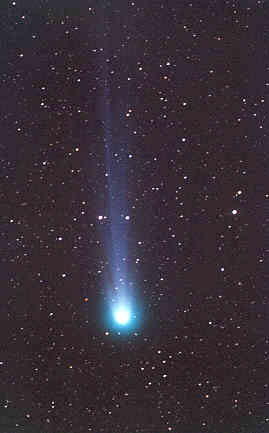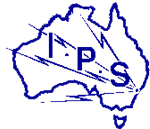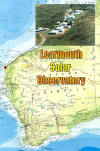|
|
 |
Project Wormwood
Learmonth Solar Observatory
Studies in Planetary
Defense
and Space Debris
from
IPS Website |
 |
PLANETARY DEFENSE AT LEARMONTH SOLAR OBSERVATORY
PROLOGUE
Planetary Defense is defined as that activity concerned with protecting
the Earth and its inhabitants from destruction due to impact by a large
piece of space debris such as an asteroid or a comet.
The term "Planetary Defense" was coined by
Colonel Simon (Pete) Worden
when he was commander of the US Air Force Space Command 50th Space Wing.
It was a term to indicate the realization that we are under bombardment
from outer space. Not from an alien aggressor, but a sporadic bombardment
by naturally occurring objects in the solar system: asteroids and comets,
fragmentary space debris, which occasionally are perturbed onto a
collision course with Earth.
|
The term furthermore, is a recognition that our technology has now
advanced to the point where not only can we search for and track such
objects, but where we may also be in a position to deflect them from
their intended path, and thus avert a disaster or catastrophe.
In the sense of a program, planetary defense then has three phases. The
first phase is sometimes not stated, but it is really the most important
of them all, for without it, the other two are doomed to fail.
The three phases may be described as:
1. Recognition of the threat or hazard of cosmic impact
2. Surveillance for detection of specific threats
3. Deflection or interception of the threat
Recognition is an awareness, by a broad spectrum of the population that
there is a threat. It may be infrequent, but when it occurs it is
devastating. |
 |
Surveillance of the near space environment is carried out by optical
telescopes, aided by the new CCD imaging revolution. There are several
programs, both large and small, around the world that are currently
dedicated to searching the skies for potential impactors. Surveillance
also includes the computer systems (both software and hardware) that
keep track of the many tens of thousands of asteroids and comets that
have been discovered, and search for possible orbital intersections with
the Earth.
|
 |
The third phase, of
impact mitigation, has been much discussed, but
there has been no universal consensus on how an impact threat should be
handled. There are currently no programs anywhere in the world that have
a defense in readiness.
Project Wormwood is a small program run by
IPS Radio and Space Services
(a unit of the Australian Government Department of Industry, Tourism and
Resources) and established at Learmonth Solar Observatory to participate
in the first two phases of Planetary Defense. |
LEARMONTH SOLAR OBSERVATORY
Learmonth Solar Observatory (LSO) is located on the North West Cape of
Western Australia at approximate coordinates 22 degrees south and 114
degrees east.
Established in 1979, it is jointly managed by the
US and Australian
governments. It is staffed by four different organizations -
the US Air
Force Weather Agency, the US National Oceanic and Atmospheric
Administration, the USAF 15th Communications Squadron (Maintenance), and
the Australian IPS Radio and Space Services. It is a real-time space
weather patrol observatory that monitors the near space environment. Two
principal solar observatories, one hosting a suite of solar radio
telescopes, and the other hosting an optical solar telescope, are on
site. Ionospheric and geomagnetic sensors provide information on the
geoeffectivenes of solar activity. Several international scientific
research projects are also hosted at LSO. These include the
GONG helioseismic laboratory run by the US National Solar Observatory, and a
station of the Japanese 210 degree Magnetic Meridian network run by the
Space Environment Research Centre of Kyushu University.
LSO has also hosted other programs from time to time, including a meteor
radar from Genesis Software (Adelaide), to monitor the 2001 Leonid
meteor storm.
Further information on LSO can be found at the IPS web site
www.ips.gov.au. This includes a
color brochure on the Observatory in
pdf format. Also available in near-real time is the space weather data
acquired and processed at the Observatory. This includes a Solar Radio
Spectrograph display which covers the frequency range of 25 to 180 MHz.
As well as solar phenomenon, radio echoes (from distant transmitters)
reflecting off meteors and re-entering space debris may occasionally be
seen on this display.
HISTORY
Interest in Planetary Defense at Learmonth Solar Observatory and by
IPS
Radio and Space Services first started in 1995 following a visit to the
site by then Colonel Simon (Pete) Worden, Commander of the 50th Space
Wing of the US Air Force Space Command.
Colonel Worden briefed Observatory staff on his concept of Planetary
Defense and outlined a small program to evaluate the use of the
Learmonth site for detection and measurement of near Earth objects. The
program was called RDOS for Rapidly Deployable Optical System. Details
of the program can be found at RDOS installation. The choice of
Learmonth for a site was primarily made on the basis of the high
percentage of cloud free days experienced. A survey conducted by the US
National Solar Observatory measured an average of 78% cloud free cover,
and rated Learmonth second only to a mountain site in Chile (with 81%
cloud free cover) with regard to this parameter, out of 15 sites
surveyed worldwide.
Unfortunately, due to several manufacturing deficiencies encountered with
the telescope system, it was returned to the manufacturer after a few
months. A dome to house the RDOS was received after this time, and this
was erected on an
|

Rising from the ashes. A new Sirius Dome awaits construction, following
the removal of the now destroyed RDOS dome. |
antiseismic pad. Unfortunately, in the interim, there
was a change of command at 50th Space Wing, and the telescope was never
returned to Learmonth.
On March 22, 1999 Tropical Cyclone Vance, a maximal class category 5
cyclone swept over the North West Cape area, producing winds (recorded
at the Learmonth Meteorological Office) up to 277 km/hour, the highest
ever recorded on the Australian mainland. Destruction of LSO
property
was minimal, but the RDOS Observatory had its dome top removed and
destroyed.
In the year 2000,
IPS funded for a new domed observatory, this one
purchased from Sirius Observatories in Queensland. This was erected on
the former pad.
In early 2001, IPS hosted a visit by two officers of the US Air Force
Office of Scientific Research, Dr Clifford Rhoades and Major (Dr) Paul
Bellaire. Following this, a research grant was made available by
AFOSR
to acquire equipment to restart observations of near Earth objects at
LSO. Equipment selection and acquisition was also made possible by the
very generous assistance of the US Spacewatch Project (Dr Robert
McMillan and Ms Therese Lane). This led to birth of Project Wormwood.
We should also acknowledge, at this stage, the Norcape Observatory,
owned and operated by Alex Liu in Exmouth (36 km to the North of
Learmonth, and the only town on North West Cape). His observing
experience (with Schmidt Cassegrain telescopes) has been invaluable in
our education in this field. Although Alex is primarily interested in occultations (of stars by asteroids) and variable star measurements, he
has been persuaded from time to time to image near Earth objects.
PROJECT WORMWOOD
|
"The third angel sounded his trumpet,
and a great star, blazing like a torch,
fell from the sky on a third of the rivers
and on the springs of water
- the name of the star is Wormwood."
Revelation 8:10-11
|

Telescope, mount, cameras and associated equipment arrived at Learmonth
Solar Observatory and were initially set up in 2003. |
-
EQUIPMENT
Software Bisque Paramount ME Robotic Telescope Mount
Celestron 14" (0.35m) Schmidt Cassegrain Optical Tube Assenbly
SBIG ST-10XME CCD Camera
SBIG STV CCD Camera (principally used as an e-Finder)
-
LOCATION
Latitude : S 22o 13' 7.4" ( -22.219 degrees )
Longitude : E 114o 6' 9.5" ( +114.103 degrees )
Altitude 12m MSL
-
PEOPLE
John A Kennewell (PhD) - Principal Physicist IPS/LSO
Graham A Steward - Solar Physicist IPS/LSO
-
ACTIVITIES
The majority of Project Wormwood activities will be follow-up astrometry
(position measurements) that are required to obtain precise orbits for
asteroids that have previously been discovered by other programs.
However, we hope to also engage in some limited search activity for new
asteroids. We will concentrate particularly on those areas of the sky
with declinations south of -30 degrees. Although the asteroid population
outside the declination range from +30 to -30 degrees is likely to be
significantly less than the area inside this range (ie the range
recommended by Spaceguard for NEO searches), it is also an area less
accessible to the major Northern Hemisphere search programs, and thus
offers a southern hemisphere site a search advantage. If possible, a
small amount of time will also be devoted to asteroid light curve
measurements (photometry) to help increase our knowledge of asteroid
rotation rates.
THE WORMWOOD WEB SITE
It has been previously stated that Project Wormwood will be involved in
the first two phases of Planetary Defense. The
Wormwood Observatory will
cover the second phase. This web site will hopefully contribute to the
first phase, with information in the form of short notes, papers, and
references and links to other available relevant information.
IPS RADIO AND SPACE SERVICES
IPS Radio and Space Services is the Australian Space Weather Agency,
providing advice to customers in the Australasian area on the near-space
environment, and the effects it has on communications, navigation,
satellite operations, and other technological systems.
IPS maintains a network of stations in the Australasian, Antarctic and
Pacific areas to monitor the state of the upper atmosphere, the
ionosphere and magnetosphere, and the Sun, which directly or indirectly
has the greatest influence on our near space environment.
Space weather has been defined as the application of space environmental
studies to the interactions that occur between the space environment and
the activities of humankind. In this definition, it is not only a
phenomenon, but the appreciation and effects that phenomenon has on our
lives.
An alternative definition might be: "Space weather is the state of the
space environment, the appreciation of that environment, and the effects
that environment has on our activities and ourselves."
While the Sun is the primary source of space weather, it is not the only
source. An example of an extrasolar source of space weather is the
natural space debris field (meteoroids) in which the Earth is
continually immersed. This is not constant, but varies with diurnal,
annual and longer cycles. This flux produces meteors (ionized trails in
the mesosphere) when the meteoroids are trapped by the Earth's
gravitational field, and ablate (burn up) in the upper atmosphere. These
meteors can be used for specific communications in the lower VHF band.
They can also be a source of interference in systems such as Over the
Horizon Radars. They are thus a valid source of space weather.
It is only a short step to the realization that space weather involves
not only electromagnetic fields and microscopic (atomic) particles, but
that it also includes macroscopic particles as well. And where does one
draw the boundary on the size of a macroscopic particle? When does a
meteoroid become an asteroid or a comet? We thus feel that planetary
defense lies closely allied with the field of space weather. It
certainly involves a part of the space environment that may
significantly influence the course of human activities.
Further information on IPS can be found
HERE.
|






